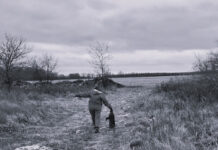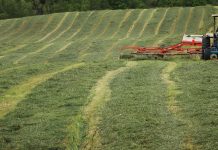
With all the necessary tools now in readiness, the unglamorous job of butchering was set to commence. The first step in the process was, of course, to dispatch the hog, which had been taken off its feed for 24 hours prior so that it had less material in its digestive tract.
This could be done by a gunshot, cutting its throat or a massive blow to the head. The killing typically took place at a location a little ways from the place where the balance of the butchering would occur. Farmers were careful that the kill site not be within sight or earshot of other livestock on the farm for fear of causing panic among them.
After the hog was killed, it was lifted onto a hog carrier or hog bier. The latter term references a bier that was used in earlier times to carry a human coffin to the grave during a funeral. The hog bier was configured like a wide ladder laid flat, which had the addition of four legs to keep the dead hog from contact with the ground. The ends of the stiles that formed the sides of the bier were extended and cut to make handholds. Thus, the bier could be borne by two, three or four men.

Scalding and scraping
The bier with the hog on it was then carried to a position right alongside a scalding trough. This trough was essentially a wooden box, 6 to 8 feet in length and about 14 inches high, with the sideboards canted inward. It was filled about two-thirds of the way with water heated in a nearby kettle to around 155 degrees.
Before the hog was rolled from the bier into the scalding trough, a series of chains was extended from the side of the bier and across the trough. This enabled the pig to be rolled from the bier and onto the chains, then lowered into the trough. By this method, the pig didn’t fall directly into the water, splashing much of it out in the process.

Once the pig was in the trough, the intent was to make it bob around. The hot water caused the pores of the skin to open up and begin to release the hair on the pig’s body. At that point the butchers began to employ hog scrapers to completely remove the hair from the carcass.
Hog scrapers were a simple tool whose use today has been largely forgotten. They were comprised of a round metal disc, slightly concave, about four inches across. From the center of the disc and perpendicular to it extended a wooden handle four or five inches in length. In some examples, the handle was made of metal and was hollow to be able to accept a candle inserted into it. These were commonly known as … wait for it … hog scraper candlesticks and they were one of the few multitools found on the frontier of the Ohio country.
The butchering crew used the hog scrapers over the entire carcass to remove every bit of hair, as well as the top layer of skin. As they worked, the carcass was repeatedly doused with scalding water.
Hoisting and skinning
After all the hair was removed, the carcass was placed back on the hog bier and knives were used to create an incision behind the Achilles tendon on each rear hoof. Into these slots were inserted the ends of a gambrel (sometimes gambol, or simply hog spreader) stick. This was a stout stick, tapered at both ends and with a series of notches cut at each end to make it adaptable to the size of the animal. Gambrel sticks were as individual as the person who crafted them. While most of them were between 24 and 30 inches in length and about two inches thick, that is where the similarity ends. Some of them were straight and some were curved. Some were simply roughed out with a hatchet while others were beautifully crafted — almost works of art for such a utilitarian tool — often with dates, the name or initials of the owner or other decoration cut in. They were frequently made in matched pairs. While gambrel sticks can still be readily found in antiques shops today, few people have any idea what they were actually used for.

With the gambrel stick inserted, the carcass was borne to the hog hanging tripod, described in the previous chapter. A chain was wrapped around the gambrel stick and the hog was hoisted upside down to a position where the ends of the gambrel rested in wrought iron hooks that were bolted into two legs of the tripod. At this point a knife was used to slice open the carcass from top to bottom, allowing it to bleed out. Because the pioneers were reputed to have used every bit of the hog “except for the squeal,” the blood was saved for later use in making blood pudding.

The next step was to use a butchering saw to remove the feet, jowls and head so that all the skin could be removed with a knife. A skilled butcher could remove most of the skin from the carcass in one piece, almost like removing a coat. Butchering saws were iron-framed saws having a fine-toothed blade similar to that of a hacksaw. They came in a wide variety of sizes and shapes, and some were designed to be used by two people at the same time with handles at both ends.
OK then, if I haven’t made you squeamish enough at this point, then brace yourself for the next chapter when the process becomes even grittier. Just remember, you really enjoy eating ham and bacon, don’t you?












